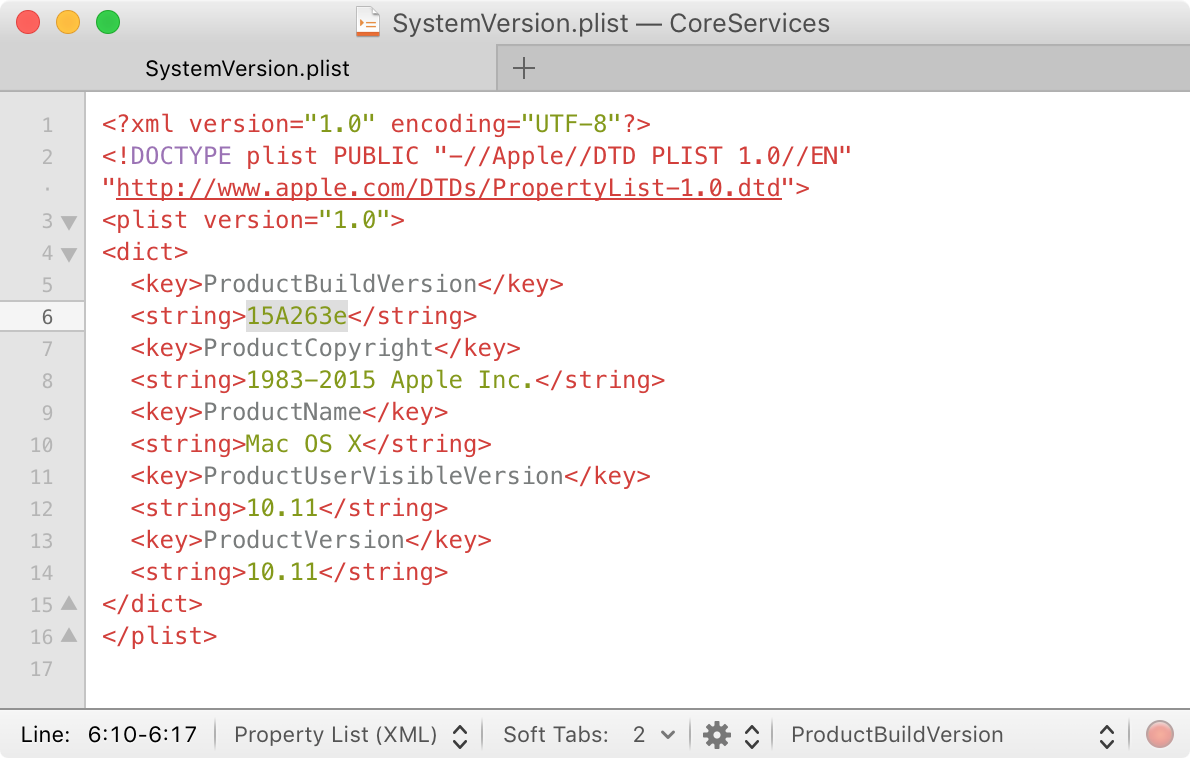- Xcode Version For El Capitan
- El Capitan Updates
- Xcode Version For El Capitan
- Xcode Version For El Capitan Version
- Xcode has a project setting for 'iOS Deployment', where you can choose that same (Xcode max) or lower iOS version that app can support. Of course you'll need a device with that lower IOS in order to use an older Xcode. Details may be involved that require certain app specifics, tho, so be prepared to meet them.
- Developers who want to make use of the Xcode 8 SDKs from the command line must choose the SDK with xcode-select. Developers on OS X El Capitan who have installed versions of the Command Line Tools (OS X 10.11) for Xcode 8 Beta should install Command Line Tools (OS X 10.11) for Xcode 7.3.1.
In this document, I will guide you how to install Mac OS 10.11 on VMWare.First of all, you must ensure that your computer have been install VMWare.VMWare version 12 is highly recommend. One can acquire skills on Xcode and use the new features supported by Mac OS X El Capitan and most importantly installing Applications on OS X El Capitan on VMware without necessarily having to install it. Running the OS X El Capitan on VMware on PC maybe somewhat hectic and may probably take a toll on one’s additional energy. Jan 11, 2017 Although during the late betas of Xcode 8 they may have offered some El Capitan support (I don’t know, as I don’t use Xcode betas) the final release with Swift 3 has been Sierra-only. Thanks for the useful info, though – at least some apps built with Xcode 8.2.1 will run on El Capitan. Jan 12, 2016 Yesterday, Apple released the first beta of iOS 9.3 and with it comes a new feature called Night Shift. Apple says that Night Shift uses your iOS device’s location and clock to automatically.
Check compatibility

Xcode Version For El Capitan
Xcode 6.4 runs out-of-the-box on: El Capitan Beta 4 (build 15A226f) El Capitan Beta 5 (build 15A235d) El Capitan Beta 7 (build 15A263e) Xcode 6.4 fails to open on: El Capitan Beta 6 (build 15A244d) - Workaround here. The last Xcode version compatible with El Capitan is Xcode 8.2.1. If you can't install it from within Apple App Store, visit Apple Developer and download the app there. An Apple ID is required. Xcode is provided as xip file (signed zip). You can simply unzip it by using Archives.app (i.e. With a double-click).

You can upgrade to OS X El Capitan from OS X Snow Leopard or later on any of the following Mac models. Your Mac also needs at least 2GB of memory and 8.8GB of available storage space.
MacBook introduced in 2009 or later, plus MacBook (13-inch, Aluminum, Late 2008)
MacBook Air introduced in late 2008 or later
MacBook Pro introduced in mid 2007 or later
Mac mini introduced in early 2009 or later
iMac introduced in mid 2007 or later
Mac Pro introduced in early 2008 or later
Xserve models introduced in early 2009
Outlook for mac 2011 not responding el capitan. To find your Mac model, memory, storage space, and macOS version, choose About This Mac from the Apple menu . If your Mac isn't compatible with OS X El Capitan, the installer will let you know.
Make a backup
Before installing any upgrade, it’s a good idea to back up your Mac. Time Machine makes it simple, and other backup methods are also available. Learn how to back up your Mac.
Get connected
It takes time to download and install OS X, so make sure that you have a reliable Internet connection. If you're using a Mac notebook computer, plug it into AC power.
Download OS X El Capitan
Max Xcode For El Capitan Update
For the strongest security and latest features, find out whether you can upgrade to macOS Catalina, the latest version of macOS.
If you still need OS X El Capitan, use this link: Download OS X El Capitan. A file named InstallMacOSX.dmg will download to your Mac.
Install the macOS installer
Double-click the downloaded file to open a window showing its contents. Then double-click the file within, named InstallMacOSX.pkg.
Max Xcode For El Capitan 7
Follow the onscreen instructions, which will guide you through the steps necessary to install.
Begin installation
After installation of the installer is complete, open the Applications folder on your Mac, then double-click the file named Install OS X El Capitan.
Click Continue and follow the onscreen instructions. You might find it easiest to begin installation in the evening so that it can complete overnight, if needed.
Allow installation to complete
Please allow installation to complete without putting your Mac to sleep or closing its lid. Your Mac might restart, show a progress bar, or show a blank screen several times as it installs both OS X and related updates to your Mac firmware.
Learn more
- OS X El Capitan won't install on top of a later version of macOS, but you can erase your disk first or install on another disk.
- You can use macOS Recovery to reinstall macOS.
Upgrading from one operating system to the another OS is the way of installing Windows or Mac operating system. In this article, you are going to learn that how to upgrade Mac OS X El Capitan to macOS Sierra 10.12. macOS Sierra 10.12 is the latest released version of Mac operating system right now. Also, you will learn that what is an upgrade and how you can do upgrade from on OS to the another version of OS.
Upgrading is the process of replacing a product with a newer version of the same product. In computing and consumer electronics an upgrade is generally a replacement of hardware, software or firmware with a newer or better version, in order to bring the system up to date or to improve its characteristics. You have two kinds of upgrading;
- Hardware upgrading
- Software upgrading
1. Hardware Upgrade
Hardware upgrading is the replacement of new hardware with the old versions. Or an upgrade is a term that describes adding new hardware in a computer that improves its performance. For example, with a hardware upgrade you could replace your hard drive with an SSD and get a huge boost in performance or upgrade the RAM so the computer runs more smoothly. Like this, you can upgrade various components of the computer.
#2. Software Upgrade
To replace (a softwareprogram)with a morerecentlyreleased,enhancedversion. For example, you may be running version 10.11 of Mac OS, version 10.12 is an upgrade, and version 10.11.x is an update. Another good example of a software upgrade is upgrading your version of Windows. For example, if you had Microsoft Windows 8.1 and were upgrade to Windows 10, it would be considered a software upgrade.
Now that you have understood the meaning of upgrading and let’s get started with “How to upgrade Mac OS X El Capitan to macOS Sierra 10.12”.
Upgrade Mac OS X El Capitan to macOS Sierra 10.12
To upgrade Mac OS X El Capitan to macOS Sierra 10.12, the latest updates from Apple.Inc, Download the macOS Sierra 10.12.1 latest version from Apple App Store.
#1.Open Apple App Store then navigate to Featured tab. Find macOS Sierra from right sidebar on app store then click on. Finally, you’ll see the snapshot below and click Download. Type your apple ID with the password. It will automatically download macOS Sierra 10.12.1 in the Applicationfolder on your Mac device.
#2. Once the download process is completed navigate to the Applicationfolder or just launch the launchpad then click on macOS Sierra setup. macOS Sierra Welcome window will appear. Click Continue.
#3. Agree to the software license agreement and then hit the Agreebutton.
Agree to the License agreement
#4. If you’ve multiple disks on your device, select one of them and hit the Installbutton and click Continue
#5. It will take a minute or less than a minute. Right after that, your computer will restart.
Installing macOS Sierra on MacBook Pro
#6. Click the “Restart” button. Keep in mind that your computer may restart more than once during installation.
Restarting macOS Sierra 10.12
Right after clicking on Restart button, your device will automatically restart and you have to wait for some minutes to complete the installation.
#7. This may take up to 30 or 40 minutes to finish the upgrading process so just relax and set back. The duration of installation is depending on your device processor, SSD, and RAM.
#8. Now, enter your Apple ID with the password. If you were already signed in. The below screen shot may appear. Enter your Apple ID’s password or choose “Set up Later“.
Enter your Apple ID with Password
#9. In the “Diagnostics & Usage” window click “Continue“.
Diagnostics & Usage
#10. Enable “Siri” if you wish then hit the “Continue” button.
Conclusion
Here we go. It’s finished now enjoy using new Apple desktop operating system “macOS Sierra 10.12”. If you have any question regarding this or our other posts, feel free to let us know. Thanks for being with dear friends.
macOS Sierra Final
- The last Xcode version compatible with El Capitan is Xcode 8.2.1. If you can't install it from within Apple App Store, visit Apple Developer and download the app there. An Apple ID is required. Xcode is provided as xip file (signed zip). You can simply unzip it by using Archives.app (i.e. With a double-click).
- I'm trying to update my XCode for El Capitan. The App Store seems to download it (no clue where to find any progress bar on that) and it just spins for hours. Yes it's a big download but it doesn't progress overnight. So I chose to download it and I chose 11.3.1, which can't be run on El Capitan.
Xcode 7.3
Install xcode command line tools 2020, Dec 04, 2020 4 thoughts on “ Upgrading to MacOS 11.0 (Big Sur) ” jonjbar 4 December 2020 at 2:43 pm. A few notes from a fellow (Windows) software developer: – Always use virtual machines to develop so that you could simply spawn a new machines and upgrade your guest or host OS independently. Xcode 12.3: Download Xcode.DMG Installer for Mac via Direct Link Uninstall iOS 14.4: Downgrade iOS 14.4 / iPadOS 14.4 to iOS 14.3 on iPhone, iPad, iPod Download macOS Mojave 10.14.6 Final.DMG Without App Store Direct Links.
Xcode includes everything developers need to create great applications for Mac, iPhone, iPad, and Apple Watch. Xcode provides developers a unified workflow for user interface design, coding, testing, and debugging. The Xcode IDE combined with the Cocoa frameworks and Swift programming language make developing apps easier and more fun than ever before. Xcode includes the Xcode IDE, Swift and Objective-C compilers, Instruments analysis tool, simulators, the latest SDKs, and hundreds of powerful features.Xcode 7 includes Swift 2 and SDKs for iOS 9, watchOS 2, and OS X 10.11 El Capitan.
Xcode For Mac 10.11.6
Version 7.3:

El Capitan Updates
Note: Now requires OS X 10.11 or later.- iOS and OS X playgrounds in Xcode are interactive and respond to user-generated events such as button clicks and iOS gestures
- Code completion offers more intelligent suggestions, including options based on the first letters of words within the API
- Devices window supports switching between multiple Apple Watch devices paired to a single iPhone
- Debugger automatically imports the frameworks needed when evaluating both Swift and Objective-C expressions
- View debugging adds additional inspector information, context menus, and Assistant editor options
- Static analyzer identifies more potential issues related to nullability and Objective-C generics
Xcode For Os X 10.11.6
- Title: Xcode 7.3
- Developer: © Apple Inc.
- Compatibility: OS X 10.11 or later, 64-bit processor
- Language: English
- Size: 4.84 GB